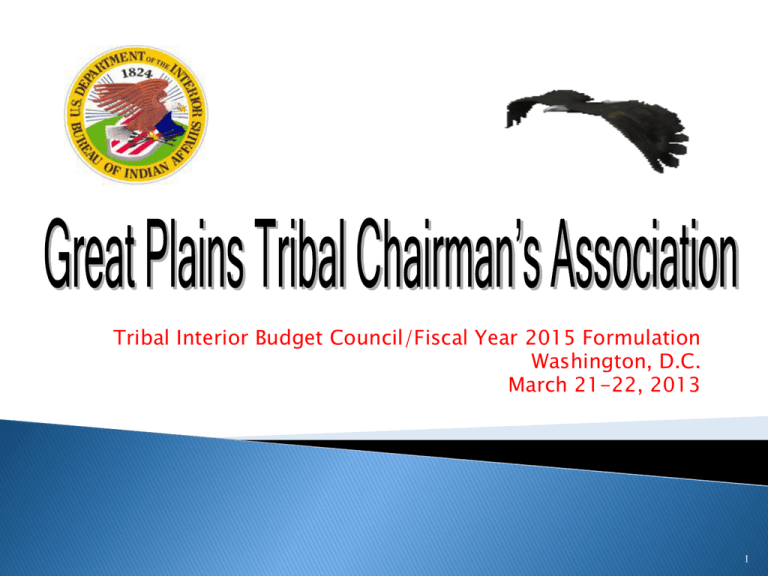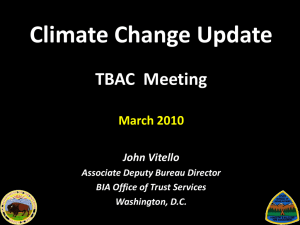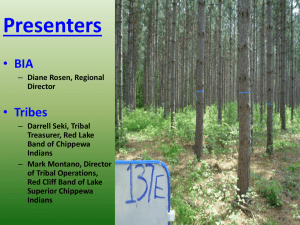Great Plains Region
advertisement

Tribal Interior Budget Council/Fiscal Year 2015 Formulation Washington, D.C. March 21-22, 2013 1 Tribal Representatives Tex Hall, Chairman, Three Affiliated Tribes of North Dakota Robert Shepherd, Chairman, Sisseton-Wahpeton Oyate’ Alternate: Kevin Keckler, Chairman, Cheyenne River Sioux Tribe Regional Office Representatives Weldon Bruce Loudermilk, Regional Director Alice Harwood, Deputy Regional Director, Indian Services Ernest J. Pourier, Regional Budget Officer (Acting) 2 Treaties define our unique relationship with the Federal Government and predate the Constitution of the US. Treaties are recognized under the United States Constitution, Article VI; and shall be the Supreme Law of the land. All interests of the Great Plains Region should be protected; the best insurance for the Great Plain Region long term survival is to have full funding to maintain healthy, productive, safe, knowledgeable environments so the tribal citizens of the Great Plains Region can be full partners in the American Economy. Therefore, funding appropriated and distributed for services to Tribes and their members is based on the fact the United States Government has a fiduciary trust responsibility under the treaties to protect tribal/Indian property, land, rights and resources. Today’s Government funding cynically masks the fact that the United States is just providing uncertain erratic handouts; these funds should not be viewed as entitlements or discretionary; they should be protected and guaranteed quid pro quo treaty benefits. 3 4 Large land-based tribes, particularly rural tribes, bear a greater responsibility for more comprehensive governance, public services, and resource management, including adequate funding across a broad range of programs. This challenge is often exacerbated in areas of concentrated poverty. Cost calculations need to accommodate and allocate additional funding for these unique circumstances affecting tribes’ responsibility for large geographic areas. Regional priorities and funding would better serve the diverse needs of tribes as opposed to national priorities, which favor small tribes. 5 The Great Plains treaty tribes are opposed to ranking and prioritizing programs in Indian Country. All programs are basic life critical necessities that historically have never been 100% funded. All TPA programs are a priority and essential to the overall livelihood of the tribal members and the operation of the Great Plains tribal governments. However, as the budget process requires a program prioritization this requirement has been met. It is indicative that the 2012 and proposed 2013 budget cuts will impact future budgets. As it stands, the President’s commitment to Indian Country and the Bureau’s Mission Statement are not supported in any previous budgets and to support further budget cuts in the proposed 2013 budget is sending the wrong message to Indian Country. BIA programs are being decreased or eliminated based on the assumption that other federal departments or agencies are fulfilling those roles or responsibilities to tribes and their membership. Tribal access to those funds becomes limited because of the lack of communication from other federal and/or state agencies. The Great Plains tribes have consistently objected to the reorganizing of line authority and funding away from BIA . 6 Tribal Priority Allocations • Aid to Tribal Government Office of Justice Services • Law Enforcement • Tribal Courts • Corrections (including Facilities O&M) Human Services • Social Services • Welfare Assistance • ICWA Transportation • Road Maintenance • Indian Reservation Roads Program Education • • • • Scholarships and Adult Education (TPA) JOM Elementary and Secondary (ISEP) Other Education priorities include: Early Childhood Education (FACE/Baby FACE), Full Funding for School Facilities and Operations; Preservation-Retention of Tribal Culture through support of Tribal Specific Standards, Assessments and Education Departments. 7 Central Office Oversight • • • • Administrative Services Executive Direction Information Resources Technology Assistant Secretary Support Regional Oversight Functions • • • Tribal Government Human Services Resource Management Forestry Self Governance Compacts Invasive Species (Noxious Weeds) Indian Arts and Crafts Board Community Fire Protection Rental GSA Direct 8 Tribal Priority Allocations (TPA) is a group of programs within the Bureau of Indian Affairs (BIA) annual budget that provides funding for: BIA Agency Operations, Tribal PL 93-638 self-determination contracts and BIA Regional Office field operations. Tribal Priority Allocations funding is important because it supports tribal self-determination contracts. Many tribes, especially those that do not have significant sources of tribal revenue; depend upon TPA funding for the operation of tribal government functions in the areas of human services, economic development, natural resources management, judicial services and tribal operations. 9 The Great Plains Tribes continue to experience insurmountable problems when attempting to provide law enforcement and judicial services to our people. This is due to four factors: (1) the federal government’s increased reliance on funding from totally ineffective DOJ programs, (2) current BIA funding does not address the costs of providing basic services to large populations across great distances, (3) current funding does not account for our broader scope of tribal jurisdiction and lack of state police services, and (4) our inability to adjust our programs because the BIA has removed public safety decision making from the Agency/Regional level. The Law and Order Act has had virtually no impact on the Great Plains Tribes, and it will not have a positive impact until the aforementioned problems are addressed. It is time for the BIA to reassume its primary responsibility for funding and providing onreservation public safety services, including the primary responsibility for funding tribal law enforcement, courts, emergency communications and the construction and operation of all court and public safety buildings. What is happening now is simply not working! DOJ programs are unreliable. They operate without needs based priorities- spending large dollars on tribes which have only concurrent jurisdiction over police matters- and they fail to establish the reliable sources of funding our programs need to operate effectively. Additionally, DOJ facilities construction programs have created nothing but problems. 10 The BIA has to get back into the jail and court construction business. DOJ lacks the funds and the mechanism to replace the large jails and courts required on our large reservations. Unfortunately, these are the projects which are currently at the top of the construction priority lists. DOJ also lacks the ability to plan for O & M, staffing, training and equipping the jail construction projects that it does undertake. This is why construction is, and should remain, a BIA responsibility. Once replaced or repaired, facilities are also allowed to fall apart. The U.S. has consistently requested less that 60% of the building maintenance dollars that its own formulas have determined are actually needed. This is a total waste of tax payer dollars. 11 Given our level of deficiency, the small law enforcement and judicial increases the administration has provided have made little difference for us and in fact are not even keeping up with our increases in gasoline prices. 12 • The 2009 Tribal Law and Order Act is an unfunded mandate requiring tribes to implement additional services. • Historically, funding for tribal courts has come from within either the tribe’s own coffers or from their TPA appropriations. • Increases of Law Enforcement activity have imposed a greater demand to tribal court systems without funding. • The tribes in the Great Plains Region would like to see a point-ofcontact at the regional level to provide technical expertise in updating and implementation of individual law and order codes, court processes, separation of powers, and corrective action plans. • Although the review conducted by an independent private contractor recommended funding increases of $10 million above the 2010 enacted funding level, not all Tribes received increases to their baseline funding. . 13 Human Services includes Child Protective Services, ICWA, Welfare Assistance (General Assistance, Child Assistance, Custodial Care of Adults, Burial Assistance, and Emergency Assistance), and associated administrative costs (TPA). A February 2013 U.S Census report indicates that South Dakota has the highest Indian poverty rates of any state. The Great Plains Region’s reservations are home to five out of the ten poorest counties, including the poorest county in the entire country, in the nation (4 in South Dakota and 1 in North Dakota) according to 2010 U.S. Census Bureau data. From 2002 to 2009, inclusive, Indian children represented 13.0-14.9% of the State child population in South Dakota, yet 40.4-51.3% of the child abuse/maltreatment victims. For the same years, Indian children represented 8.3-9.1% of the State child population in North Dakota, yet 19.3-29.8% of the child abuse/maltreatment victims. For the same years, Indian children represented 1.2-1.3% of the State child population in Nebraska, yet 5.0-7.2% of the child abuse/maltreatment victims. There are an estimated 50 cases per 1 Social Worker for some child protective services (abuse and neglect cases) programs despite national standards recommending only 12-15 child protection cases per worker, and 1 social worker per month per 40 active foster care cases despite national standards recommending only 12 foster care cases per worker. The General Assistance program provides financial assistance payments to eligible Indians as a last resort resource for essential needs such as food, clothing, and shelter. Due to lack of funding, it is not uncommon for individuals and families served under BIA and 638-contracted programs to be cut off of this basic subsistence resource later in the fiscal year as funding is exhausted. 14 The 2013 Greenbook Budget justification is misrepresentative and discourteous to Great Plains Region tribes. In addition, the proposed reduction of this activity to fund “New Tribes” further demonstrates the Administration’s lack of commitment to the needs of Large Land Based tribes. Current funding is about 12% of need Routine bridge maintenance is not being performed unless it becomes an emergency Snow & ice control can take up to 35% of an annual budget Tribes feel that the government should fully fund road maintenance and not rely on the tribe’s road construction funds to perform road maintenance The FHWA construction dollars are supplemental; not in lieu of TPA allocations 15 All 16 Tribes within the Great Plains Region signed a Treaty with the United States Government and most are a party to the 1868 Treaty between the Sioux Nation and the US, that guaranteed education for tribal members in perpetuity. For example, Article 7 of the 1868 Ft. Laramie Treaty states that: “In order to insure the civilization of the Indians entering into this treaty, the necessity of education is admitted, especially of such of them as are or may be settled on said agricultural reservations, and they therefore pledge themselves to compel their children, male and female, between the ages of six and sixteen years, to attend school; and it is hereby made the duty of the agent for said Indians to see that this stipulation is strictly complied with; and the United States agrees that for every thirty children between said ages who can be induced or compelled to attend school, a house shall be provided and a teacher competent to teach the elementary branches of an English education shall be furnished, who will reside among said Indians, and faithfully discharge his or her duties as a teacher.” The Great Plains Region has one of the most of the Bureau of Indian Education (BIE) Schools. Of the $2.4 billion appropriated for the Operation of Indian Programs, Nearly 20% of the funding is in the BIE budget. At least 20% of the funding should come to the Great Plains Region. Of the funds received to operate schools the BIE uses twothirds (2/3) for administrative activities and the schools receive one third (1/3) of funds to operate. $22,000 plus is allocated per child but local funding only receives $7,900 per child. BIE is top heavy with high paid staff the emphasis must shift to more funding at the local level where education of our children is taking place. Eliminate Positions at the Central Office of the Bureau of Indian Education and increase and retain Education staff at the local Agency and the tribe’s Tribal Education Department/Agency become the SEA. BIE should be a pass through agency for funding and let the Educators at local level determine their reading programs, curriculum etc. Adhere to the findings in The Bonner Report Recommendations and implement the Recommendations. The Bonner Report recommendations that Tribes agree BIE needs to follow up on prior to any proposal being developed include: • Re-organization must not be done until full consultation and study is done with tribal leaders. • Thoughtful, Effective Implementation is Critical. • Centralization is not effective. • Reorganization must address the fact that, “Indian affairs relies on personal relationships rather than organizational structure, to complete administrative tasks.” • The structure is poorly served by a wholly inadequate communications and coordination program. • Budget formulation and funds management should be restructured to Regional Office level instead of centralized offices. • Supervision of OBM functions should be under Regional offices and not central office function. The Bonner Report recommendations that Tribes agree BIE needs to follow up on prior to any proposal being developed include: • Indian affairs would achieve improved customer service and accountability with local supervision of the Contract Specialists by the BIA Regional Directors. BIA should consider streamlining processes and eliminating unnecessary approvals. • Property Management Should be under regional BIA office supervision. • Facilities managers need to report to regional directors and BIE should sign MOU with BIA to provide this service. • Centralization of the human resources staffing function is not effective! • Equal Employment Office needs to be established. • NEED A SMALLER DAS SERVICE to improve “customer service” after full consultation with tribal leaders. It will be most cost effective to return BIE under Regional and Agency BIA Supervision. Tribes want more local control to set up their own Tribal Codes, Accreditation and Standards. Fund the Tribal Education Offices. Eliminate the middle management offices and move the majority of the funds and functions to the Line Offices. These offices include the Associate Deputy Directors of East, West and Navajo, Associate Deputy Director-Division of PostSecondary Education, and some staff positions in the Director’s office. Eliminate the Division of Compliance, Monitoring and Accountability and move the majority of the funds and functions to the line offices. A small amount of the functions could be moved to central office. Move Line Offices that are not on reservation lands to reservation lands. Home Improvement Program Increase the Federal Income Poverty guideline eligibility from 125% to 225%. Rating for eligibility criteria should be revised to address housing needs. The 2012 need for the Large Land Base Great Plains is $228.5 million vs the current minimal amount of $25 million Bureau wide. Other Issues: -Many houses are dilapidated and have black mold creating health issues. -The Tribal leadership has stated that the reservations have turned into “trailer house grave yards”. -The waiting list at the Indian Housing Authorities are long, with 5 plus years and no guarantee of housing placement. -The housing need is great, but it is impossible to capture an accurate count as many will not come forward to be counted. For example, many are homeless or are in fear of being evicted from their home due to the fact that “unauthorized” family members are residing with them in homes governed by stringent federal guidelines. 21 22 23 The protection of land and natural resources is critical to maintaining the Great Plains tribal land base. The Region has one of the largest land bases in Indian Country and the most fractionated interests. Limited funding resources have not allowed the BIA to fulfill it’s trust obligation in protecting and enhancing these resources for the 1.7 million land owner and tribal interests. Great Plains Region has the responsibility for managing and protecting 6.1 million acres of tribal and allotted lands for approximately 90,000 individual land owners. • Annual value of grazing to the Indian landowners and Tribes is approximately $18 million and approximately $14 million for farm pasture and farm leases. 24 • 25 CFR 166 requires the development of Reservation specific Agricultural Resource Management Plans (ARMP) and Range Unit specific Conservation plans to protect the trust resources of the Indian landowner. • Lease Compliance and Unresolved Rights funding must be restored. These activities continue to operate but at the expense of other TPA programs. • Create a permanent funding source for Tribal Historic Preservation Offices appropriated through the Department of Interior as per the DOI Strategic Plan for 2011-2016. 25 • The 2010 National Census data revealed the following South Dakota counties as the 4 of the 10 poorest in the nation: Ziebach (Cheyenne River Sioux Tribe),Todd (Rosebud Sioux Tribe), Shannon (Oglala Sioux Tribe) and Corson (Standing Rock Sioux Tribe.) It is an epidemic that needs Congressional attention to aide the tribes in moving towards reducing the poverty levels that plague the Great Plains Region. • The average unemployment rate in the Great Plains Region is 77%. Economic Development is imperative to improving the quality of life for tribal members through job creation. 26 • • • • • Reverse the consolidation of the functions and authorities of the Office of Indian Energy and Economic Development Office back to the BIA Regional Office and Agency level to reverse the reduction of service and regular tribal consultation inherent in the new stove piping of this program. Tribes within the Great Plains Region lack the economic resources and infrastructure to jump start their economies and to fully implement the Department’s initiatives for alternative and/or renewable energy projects. Allow tribal input on revising regulations and provide experts to fit tribal needs. The tribes must have the opportunity for participation in proposed changes and evaluations affecting the Indian Financing Act or other economic development programs. The Great Plains Tribes are opposed to the proposed $2.1 million reduction to the Guaranteed Loan Program for FY 2013. Grants/Funding should be appropriated for Great Plains Tribes to develop, train and implement Uniform Commercial Codes for economic development (employment opportunities). 27 • The fundamental obstacle to tribal P.L. 93-638 contracting has historically been the lack of full funding for direct support and contract support costs. Full contract support funding is critical to the tribes abilities to implement and maintain their self determination status. • The Great Plains Tribes support the increased funding for direct support and contract support costs in the proposed 2013 budget. 28 Law Enforcement, Yankton Sioux Tribe Northern Plains Appellate Court (ineffective), Ponca Tribe Road Maintenance (Green Book). Justification misleading Funding Formula should be based on direct tribal demographics reporting and treaty based. Land based emphasis. Public Safety and Justice is one cohesive unit (law enforcement, 911 dispatch, corrections, tribal courts) Tribes in Great Plains operate as full functioning “governments” as large land based tribes identified in the DOI strategic plan Indian Preference must be adhered to Reduce high level SES positions across the board and add funding to the tribal level OIEED, OST, BIE, OJS, OFMC. Move back to Agency and Regional Office level “Sunset” OST. Functions back to Indian Affairs 29 Creation of a Cabinet Level Position for Indian Affairs. Create a special category for Large and Needy Tribes Restructure Indian Affairs and realign all programs, including FTE’s and funding, back to the Bureau of Indian Affairs. Eliminate Stove Piping. Utilize ALL unobligated balances under the Assistant Secretary oversight (BIA, OJS, BIE, OST, Economic Development.) Funds must be provided for the continued development of the United Tribes Technical Training College Law Enforcement Training Center. Internal budget changes always have a negative impact to Tribes. Administrative Savings and Fixed Costs leave budgets flat with no realization of funding increases The BIA, OJS and DOJ must meet and work with Tribes to develop strategic plans. The BIA must work with Tribes to develop GPRA measures that are meaningful and provide training to BIA and tribal officials on the GPRA measures. Tribes in the Great Plains Region are requiring technical assistance from OPPM to develop strategic plans and measures that meet and exceed GPRA reporting requirements to protect funding and programs Eliminate Deputy Superintendent functions and redirect funding to establish local Self Determination Awarding Officials and GPRA specialist. 30 President Obama’s Strengthening Tribal Nations Initiatives, particularly Advancing Nation-toNation Relationships, is a good concept but not reflected across the board. Organizational Restructuring Elimination of Programs Reduction of Funding Unfunded Mandates Changing the definition of an Indian 31 32








